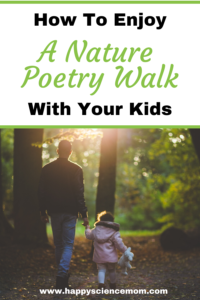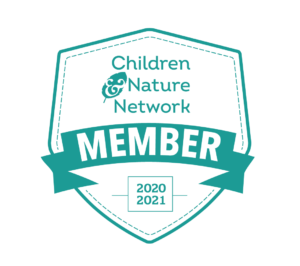 Going on a nature poetry walk is such a beautiful, relaxing, creative, and mindful experience that I highly recommend you try with your children. I’ll never forget going on my first precious nature poetry walk last summer in Pennsylvania at a spa resort that offers incredible outdoor and mind and body classes. It’s an adventure that will always have a special place in my heart.
Going on a nature poetry walk is such a beautiful, relaxing, creative, and mindful experience that I highly recommend you try with your children. I’ll never forget going on my first precious nature poetry walk last summer in Pennsylvania at a spa resort that offers incredible outdoor and mind and body classes. It’s an adventure that will always have a special place in my heart.
We left the hotel as a group not knowing what to expect. Our leader asked us to start following her along the winding trail, but she requested that we walk very slowly and stay silent. We meandered into an area where there were bushes and some sporadic trees. When we were far enough away that we could no longer see the building, we spotted a large brown deer. We all stared in amazement since we were so close to wildlife. We noticed him more than he noticed us. We then kept walking and I remember a squirrel jumping out in front of us, almost as if he was trying to say hello and usher us through our hike.
We continued to walk a bit up a small hill and came to a tree that had a swarm of buzzing bees above it. Although we were a bit frightened and made sure to keep our distance and tiptoe around it, this was a huge moment during our nature walk—which was later evident by all of our poems mentioning the bees. After this tense moment, we entered a gorgeous, colorful garden filled with bright yellow sunflowers and neon orange flowers. Finally, we made our way to an area around an inviting, sturdy tree. A couple of women sat on the grass, one plopped down on a gray boulder, and I joined two others on a lovely tree swing. I will never forget how calming it was to sway back and forth in the breeze while crafting my poem after the walk.
Why A Nature Poetry Walk?
The main goal of a nature poetry walk is to soak in the beauty of our surrounding environment and then turn that experience into something creative that we can treasure. Writing poetry requires inspiration, and nature is the perfect backdrop for us to find that spark.
The best way to do this is to use our five senses. Instead of just walking like you would on a typical hike, it’s important to purposely slow down and stop once in a while to take in what is all around. During my nature poetry walk, our leader asked us to stop several times along the path and think about what we saw, heard, touched, smelled, and even tasted. She encouraged us to breathe in the air deeply, to look all around us, and to bend down and feel various items along the way. This mindful exercise forces us to really stop and absorb our environment and all that it has to offer.
Benefits
Nature poetry walks provide so many incredible benefits to our children including the following:
Keeps Us Moving. Exercise in itself has so many benefits, so going on a family walk together gets everyone moving around a bit more. Be sure that you and your children wear comfortable shoes to enjoy your time outside. Chances are that after the mindful walk and writing time, the kids will want to run around for a while to burn off their energy.
Teaches focus and mindfulness. According to the Poetry Foundation, poets look at the world the way scientists do, observing all the details to discover interesting concepts and patterns. Going on a poetry walk is a wonderful way for your family to slow down and move mindfully through whatever environment you choose, whether it be the woods, mountains, beach, or your neighborhood park. Your kids will love slowing down and noticing the simple, yet intriguing parts of nature such as a butterfly fluttering by or the scent of blossoming flowers.
Reduces Stress. Walking mindfully in nature is an incredible stress buster. It helps our bodies and minds slow down and enjoy the moment. Plus, by tapping into our five senses, we distract ourselves from our worries. Additionally, awe plays an incredible role during both the walk and while writing poetry, and awe is another tool to help us feel calmer because it helps us to view the world in a broader sense.
Helps Us Connect With Our Emotions. Experts have found that poetry is an excellent way for us to connect with and communicate our thoughts and feelings. It allows us to spend time reflecting on both our experiences and our inner thoughts. Children can use poetry to express themselves in new ways to deal with big emotions. Even young children can learn to express themselves creatively through poetry.
And children get to learn new writing skills, too!
Instructions
Here are a few pointers to get you started:
- Before you go on your first nature poetry walk, introduce your children to some nature poetry to get them interested and inspired. Here are some recommendations.
- Be sure to bring the following supplies: notebook or journal; pencils and pens; colored pencils, markers, or crayons if they want to sketch the scene they are writing about; and a phone or camera to snap some photos.
- Choose a destination for your walk. Try different types of places each time you go.
- Once you arrive at your spot, explain to your children that they should try and be quiet and walk slowly. Stop along the way to ask them what they are experiencing through each of their five senses. It’s helpful if they start to write down these observations in a chart sectioned off by each sense: sight, hearing, touch, smell, and taste.
- Enjoy the walk and go with the flow as far as what you do along the way and where you end up.
- At the end of the walk, pick a place to sit down and let your kids spend some time either writing their poetry or talking about it if they are young and need some guidance. You can also wait until you are back in the car or home for the poetry writing time, but it’s probably more effective if they at least start it outside in nature.
- To add some more creative flair to your nature poetry experience, your children may enjoy drawing or painting a picture to reflect the scene depicted in their poem. Maybe they love singing and want to turn the poem into song lyrics. You can also snap pictures during your nature poetry walk (just be careful not to let technology be a distraction) and use those photos in a slideshow or as part of a collage around the poem.
- Finally, enjoy sharing everyone’s creations with each other and talking about the experience. I hope you build special memories that help you feel happier and calmer.






I’ve never thought about going on a poetry nature walk I love this idea and will implement this activity for the children I care for. I’m also considering doing this on my own. Sounds super relaxing and fun
What a wonderful post! This sounds like so much fun and something my family definitely needs to do this Spring. Thanks for sharing!